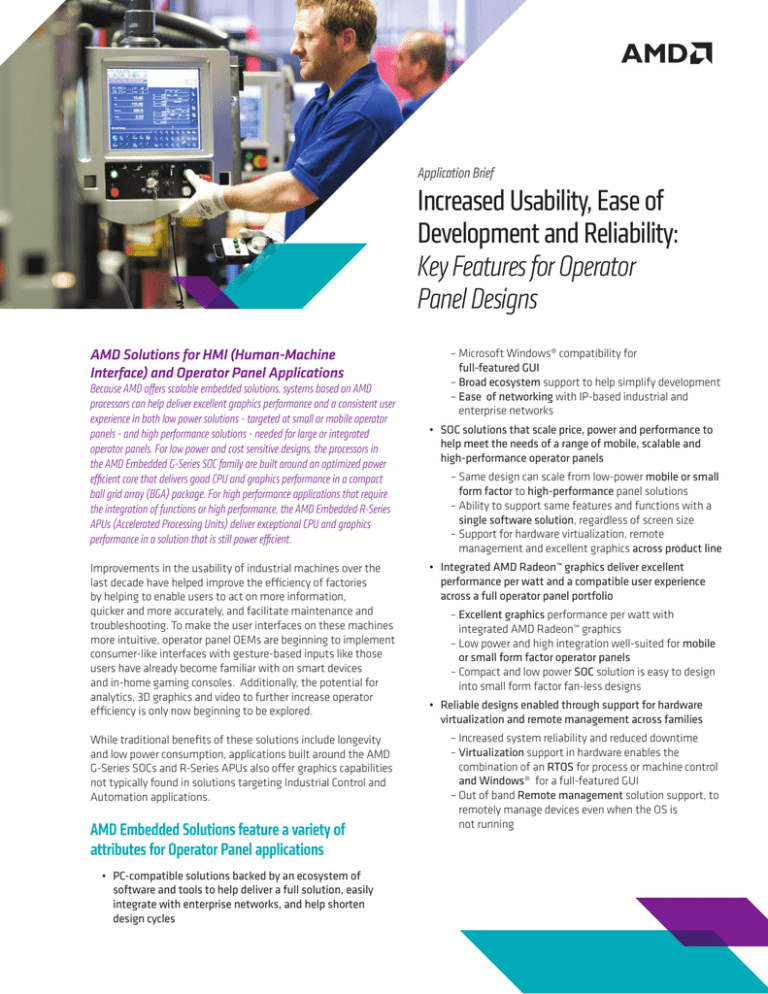
Application Brief
Increased Usability, Ease of
Development and Reliability:
Key Features for Operator
Panel Designs
AMD Solutions for HMI (Human-Machine
Interface) and Operator Panel Applications
Because AMD offers scalable embedded solutions, systems based on AMD
processors can help deliver excellent graphics performance and a consistent user
experience in both low power solutions - targeted at small or mobile operator
panels - and high performance solutions - needed for large or integrated
operator panels. For low power and cost sensitive designs, the processors in
the AMD Embedded G-Series SOC family are built around an optimized power
efficient core that delivers good CPU and graphics performance in a compact
ball grid array (BGA) package. For high performance applications that require
the integration of functions or high performance, the AMD Embedded R-Series
APUs (Accelerated Processing Units) deliver exceptional CPU and graphics
performance in a solution that is still power efficient.
Improvements in the usability of industrial machines over the
last decade have helped improve the efficiency of factories
by helping to enable users to act on more information,
quicker and more accurately, and facilitate maintenance and
troubleshooting. To make the user interfaces on these machines
more intuitive, operator panel OEMs are beginning to implement
consumer-like interfaces with gesture-based inputs like those
users have already become familiar with on smart devices
and in-home gaming consoles. Additionally, the potential for
analytics, 3D graphics and video to further increase operator
efficiency is only now beginning to be explored.
While traditional benefits of these solutions include longevity
and low power consumption, applications built around the AMD
G-Series SOCs and R-Series APUs also offer graphics capabilities
not typically found in solutions targeting Industrial Control and
Automation applications.
AMD Embedded Solutions feature a variety of
attributes for Operator Panel applications
• P
C-compatible solutions backed by an ecosystem of
software and tools to help deliver a full solution, easily
integrate with enterprise networks, and help shorten
design cycles
–M
icrosoft Windows® compatibility for
full-featured GUI
–B
road ecosystem support to help simplify development
–E
ase of networking with IP-based industrial and
enterprise networks
• S
OC solutions that scale price, power and performance to
help meet the needs of a range of mobile, scalable and
high-performance operator panels
–S
ame design can scale from low-power mobile or small
form factor to high-performance panel solutions
–A
bility to support same features and functions with a
single software solution, regardless of screen size
–S
upport for hardware virtualization, remote
management and excellent graphics across product line
• I ntegrated AMD Radeon™ graphics deliver excellent
performance per watt and a compatible user experience
across a full operator panel portfolio
–E
xcellent graphics performance per watt with
integrated AMD Radeon™ graphics
– L ow power and high integration well-suited for mobile
or small form factor operator panels
–C
ompact and low power SOC solution is easy to design
into small form factor fan-less designs
• R
eliable designs enabled through support for hardware
virtualization and remote management across families
– Increased system reliability and reduced downtime
–V
irtualization support in hardware enables the
combination of an RTOS for process or machine control
and Windows® for a full-featured GUI
–O
ut of band Remote management solution support, to
remotely manage devices even when the OS is
not running
Application Brief: HMI/Operator Panel Solutions
AMD Embedded Solutions for HMI and Operator Panel Applications
Memory
CPU 3
(opt)
DVI/HDMI™/DP
802.15.4 or WiFi
CPU 1
AMD
Embedded
G-Series SOC
CPU 0
SATA HDD
(opt)
12-48VDC
GbE
GbE
SATA v3.x
Boot Flash
• Recommended: AMD GX-210HA SOC
- Low-power at only 4.1W average power1
- Highly Integrated Dual-core SOC
- Excellent graphics performance/Watt
- Lower power/cost alternative:
AMD G-T16R APU
eDP/LVDS
CPU 2
(opt)
SD Card/
eMMC
FOR SMALL OR MOBILE PANELS
• Recommended: AMD G-Series SOC Family
- Excellent performance with balanced power
- Dual and Quad-core Scalability
- 3.3W – 10.8W Average Power 2
PCIe®/Display
• Recommended: AMD GX-420CA SOC
- Excellent graphics performance
- Quad-core x86 performance
- Higher performance alternative:
- AMD R-464LAPU
FOR SCALABLE OPERATOR PANELS
Direct® 11 GPU
FOR HIGH PERFORMANCE PANELS
HD Audio
PCIe®
IR
USB 2.0/3.0
LPC, SPI
(opt)
(Opt IEEE 1588)
(Opt IEEE 1588)
USB 2.0/3.0
RS-232
RS-232
UART
RS-232/485
RS-232/485
Remote Management
www.amd.com/embeddedsales | www.amd.com/industrial
1 The average power for the AMD GX-210HA SOC is 4.1 Watts, determined by averaging the results of the measured average power of the SOC running the following benchmarks; 3DMark® 11, AMD Sys Stress Test CPU,
AMD Sys Stress Test CPU & GPU, AMD Sys Stress Test GPU, Winbench® 99, CoreMark, Game:Meat Boy, PCMark® 7, POV-Ray, Sandra 2011, Game: Street Fighter,. Testing was performed on an AMD E1-2100 (Rev A1) that is
equivalent to the AMD GX-210HA SOC. System configuration: AMD E1-2100 @ 70°C, “Larne" development platform, 4GB RAM, Windows 7 Ultimate. Please see AMD Publication ID 53395A for more information. EMB-41
2 The average power for the AMD GX-210JA SOC is 3.3 Watts, determined by averaging the results of the measured average power of the SOC running the following benchmarks; 3DMark® 11, AMD Sys Stress Test CPU, AMD
Sys Stress Test CPU & GPU, AMD Sys Stress Test GPU, Winbench® 99, CoreMark(Multi-thread), Game:Meat Boy, PCMark® 7, POV-Ray(all), Sandra 2011, Game: Street Fighter. System configuration: AMD GX-210JA @ 60°C,
“Larne" development platform, 4GB RAM, Windows 7 Ultimate. Please see AMD Publication ID 53395B for more information.
The average power for the AMD GX-420CASOC is 10.8 Watts, determined by averaging the results of the measured average power of the SOC running the following benchmarks; 3DMark® 11, AMD Sys Stress Test CPU,
AMD Sys Stress Test CPU & GPU, AMD Sys Stress Test GPU, Winbench® 99, CoreMark(Multi-thread), Game:Meat Boy, PCMark® 7, POV-Ray(all), Sandra 2011, Game: Street Fighter. System configuration: AMD GX-420CA @
60°C, “Larne" development platform, 4GB RAM, Windows 7 Ultimate. Please see AMD Publication ID 53395B for more information.”
DISCLAIMER
The information contained herein is for informational purposes only, and is subject to change without notice. While every precaution has been taken in the preparation of this document, it may contain technical
inaccuracies, omissions and typographical errors, and AMD is under no obligation to update or otherwise correct this information. Advanced Micro Devices, Inc. makes no representations or warranties with respect to the
accuracy or completeness of the contents of this document, and assumes no liability of any kind, including the implied warranties of non-infringement, merchantability or fitness for particular purposes, with respect
to the operation or use of AMD hardware, software or other products described herein. No license, including implied or arising by estoppel, to any intellectual property rights is granted by this document. Terms and
limitations applicable to the purchase or use of AMD’s products are as set forth in a signed agreement between the parties or in AMD's Standard Terms and Conditions of Sale.
AMD, the AMD Arrow logo, AMD Radeon and combinations thereof are trademarks of Advanced Micro Devices, Inc. Windows is a registered trademark of Microsoft Corporation in the U.S. and/or other jurisdictions. Other
product names used in this publication are for identification purposes only and may be trademarks of their respective companies. PID 54070-A
© 2013 Advanced Micro Devices, Inc. All rights reserved.




